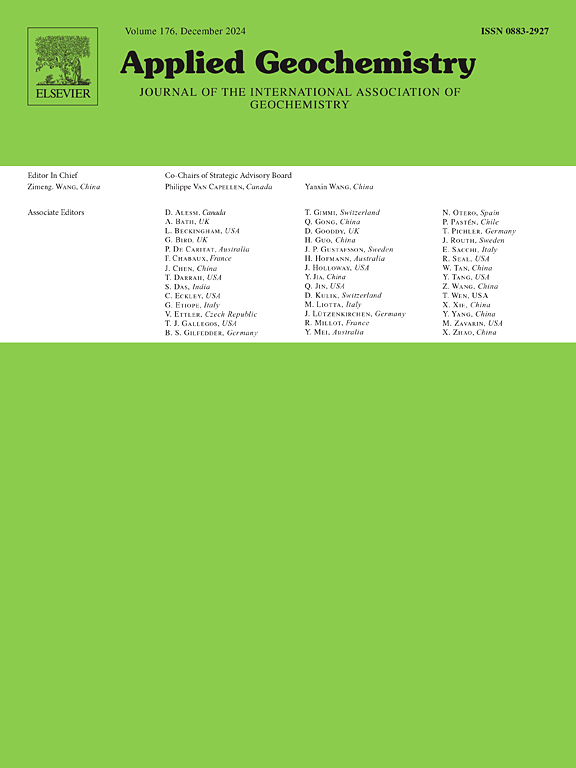Deciphering diverse colonization patterns of plastisphere generalists and specialists in greenhouse soils
IF 3.1
3区 地球科学
Q1 GEOCHEMISTRY & GEOPHYSICS
引用次数: 0
Abstract
Studies on the plastisphere mainly focus on the overall microbial community, neglecting the nuanced difference of its generalist and specialist subcommunities. To elucidate the intricacies of these subcommunities, we analyzed plastic films residues from greenhouse soils. The results revealed that the plastisphere influenced alpha-diversities of bacterial and fungal generalist subcommunities but not their specialist subcommunities. Stochastic processes governed the assembly of bacterial and fungal generalist and specialist subcommunities in plastisphere and surrounding soil, with the plastisphere intensifying the role of stochastic process, particularly in the assembly of generalist subcommunities. Furthermore, the species dispersal of bacterial and fungal generalist and specialist subcommunities was more extensive within plastisphere than in surrounding soil; however, in the biotic networks, the node ratio of bacterial and fungal specialists decreased in plastisphere compared to surrounding soils. Furthermore, the plastisphere diminished the significance of both generalists and specialists in sustaining network stability based on the topological parameters. Plastisphere induced significant enrichment of fungal pathogens, suggesting that plastic film may pose risk to plant performance and soil health. These results broaden our understanding of how plastisphere-induced interference affects generalist and specialist microorganisms, potentially highlighting the need for improved residue management to sustain ecosystem health and function.

解密温室土壤中质体通才和专才的不同定植模式
有关塑膜的研究主要集中在整体微生物群落上,而忽略了其通性和专性亚群落的细微差别。为了阐明这些亚群落的复杂性,我们分析了温室土壤中的塑料薄膜残留物。结果表明,塑膜影响了细菌和真菌通性亚群落的α-多样性,但不影响其专性亚群落的α-多样性。随机过程支配着细菌和真菌在塑球和周围土壤中的通性和专性亚群落的集合,塑球强化了随机过程的作用,尤其是在通性亚群落的集合中。此外,与周围土壤相比,质球内细菌和真菌专性亚群落和专性亚群落的物种扩散更为广泛;然而,在生物网络中,与周围土壤相比,质球内细菌和真菌专性亚群落的节点比率有所下降。此外,根据拓扑参数,质球降低了普通生物和专性生物在维持网络稳定性方面的重要性。塑料薄膜诱导真菌病原体大量繁殖,这表明塑料薄膜可能会对植物生长和土壤健康造成危害。这些结果拓宽了我们对塑料薄膜诱导的干扰如何影响通性微生物和专性微生物的认识,可能突出了改善残留物管理以维持生态系统健康和功能的必要性。
本文章由计算机程序翻译,如有差异,请以英文原文为准。
求助全文
约1分钟内获得全文
求助全文
来源期刊

Applied Geochemistry
地学-地球化学与地球物理
CiteScore
6.10
自引率
8.80%
发文量
272
审稿时长
65 days
期刊介绍:
Applied Geochemistry is an international journal devoted to publication of original research papers, rapid research communications and selected review papers in geochemistry and urban geochemistry which have some practical application to an aspect of human endeavour, such as the preservation of the environment, health, waste disposal and the search for resources. Papers on applications of inorganic, organic and isotope geochemistry and geochemical processes are therefore welcome provided they meet the main criterion. Spatial and temporal monitoring case studies are only of interest to our international readership if they present new ideas of broad application.
Topics covered include: (1) Environmental geochemistry (including natural and anthropogenic aspects, and protection and remediation strategies); (2) Hydrogeochemistry (surface and groundwater); (3) Medical (urban) geochemistry; (4) The search for energy resources (in particular unconventional oil and gas or emerging metal resources); (5) Energy exploitation (in particular geothermal energy and CCS); (6) Upgrading of energy and mineral resources where there is a direct geochemical application; and (7) Waste disposal, including nuclear waste disposal.
 求助内容:
求助内容: 应助结果提醒方式:
应助结果提醒方式:


